How much would a labradorite countertop cost?
Table of Contents
Toggle- How much would a labradorite countertop cost?
- Price ranges — material and installed
- What drives price? — the buyer’s checklist
- Labradorite vs. granite/quartz/onyx — cost and durability snapshot
- Where to buy Labradorite slabs — tips and sources
- Durability, maintenance, and recommended finishes
- Regulatory & industry trends affecting cost and supply (important to pricing)
- Pricing example — how to estimate your job
- Negotiation & procurement tips (for buyers or resellers)
- FAQ — Google hot questions (5 answers)
- Semantic closing block — How / Why / What / Options / Considerations
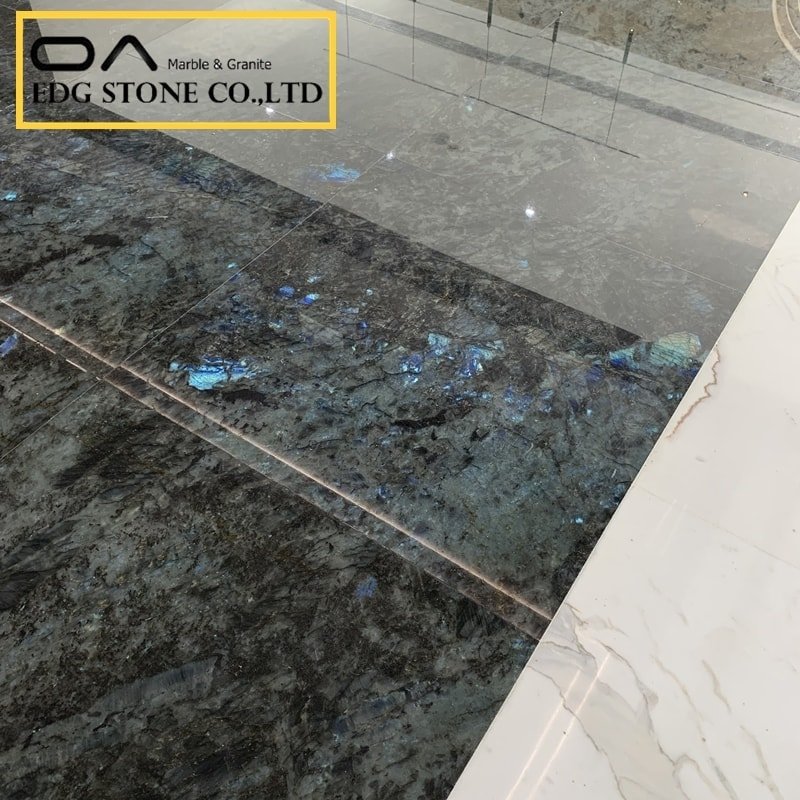
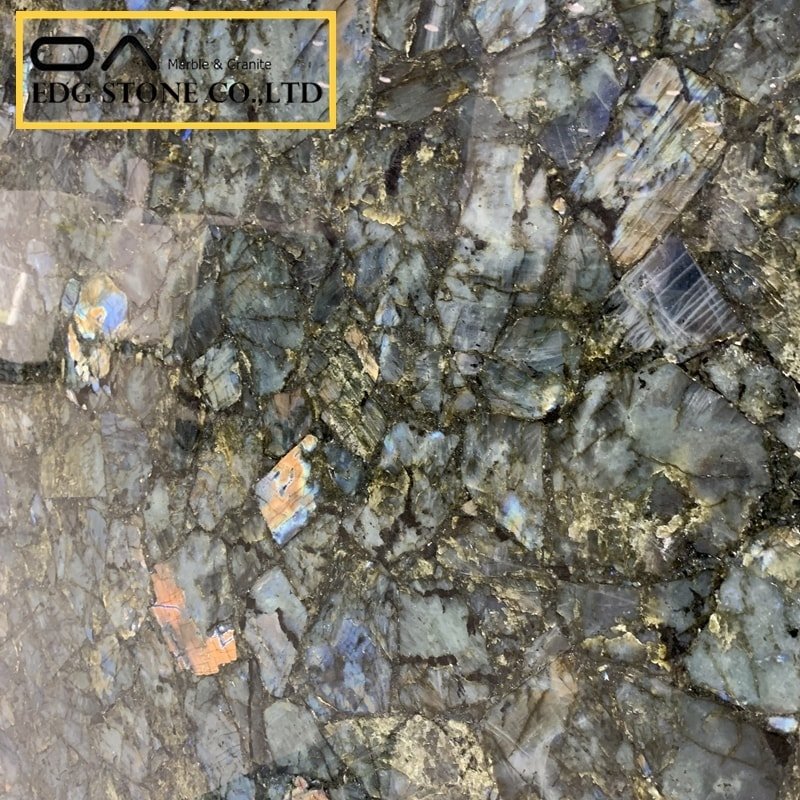
Price ranges — material and installed
Labradorite is sold and priced differently depending on format (slab vs. remnant), thickness (2 cm vs. 3 cm), and finish. Market listings and supplier quotes show wide variation:
Common supplier/wholesale slab range (material only): roughly USD $40–$160 per sq ft for many commercial Labradorite and blue Labradorite slabs.
Premium / rare / gem-quality slabs (material only): commonly USD $100–$300+ per sq ft depending on figure, flash, slab yield, and exclusivity. Some retail installers and guides list installed prices that reach the upper end of this range once labor and complexity are added.
Installed total (materials + fabrication + install): expect material + install to often fall into USD $80–$350+ per sq ft for rare pieces; many typical installations of labradorite will total more than standard granite due to extra fabrication care, matching pieces, and potential reinforcement or substrate work.
Why ranges are so broad: labradorite is often treated like a semi-precious/decorative slab—some slabs are mined and supplied as rare decorative “feature” pieces (highly figured, with exceptional flash), which élevates the piece into a near-luxury price bracket.
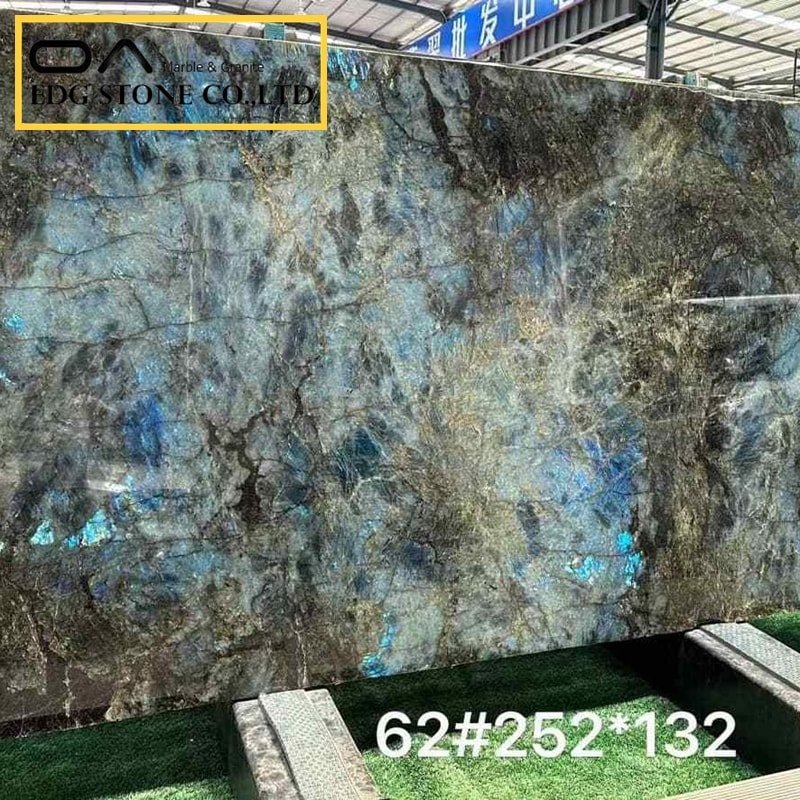
What drives price? — the buyer’s checklist
When you see different quotes, compare these line items:
Slab rarity & pattern (most important): large, continuous flash or uncommon color/figure raises price drastically. “Lemurian blue” or “spectrolite” slabs with pronounced labradorescence command premiums.
Slab yield & usable square footage: if a slab has veins, inclusions, or awkward shapes, you may need more slabs (and seams), increasing cost.
Thickness: 20 mm (2 cm) is cheaper; 30 mm (3 cm) is costlier and often preferred for premium installs. Supplier quotes typically separate 2cm vs 3cm pricing.
Finish: polished finish shows labradorescence best, but may reveal more imperfections; honed, leathered, or resin-filled options affect price and maintenance.
Fabrication complexity: intricate sink cutouts, waterfall edges, bookmatching, and island wraps add labor and time. Fabricators may charge premium hourly rates for gemstone work.
Seams & bookmatching: matching two slabs across an island or running veins seamlessly can be labor-intensive and costly.
Shipping, import duties, and customs: high-value slabs often ship from Brazil, Madagascar, India, or specialty quarries — freight and duties add to the delivered cost.
Compliance & shop overhead: dust control, wet cutting, HEPA extraction, and silica-monitoring equipment required by regulation increase fabricator overhead (see Regulations section).
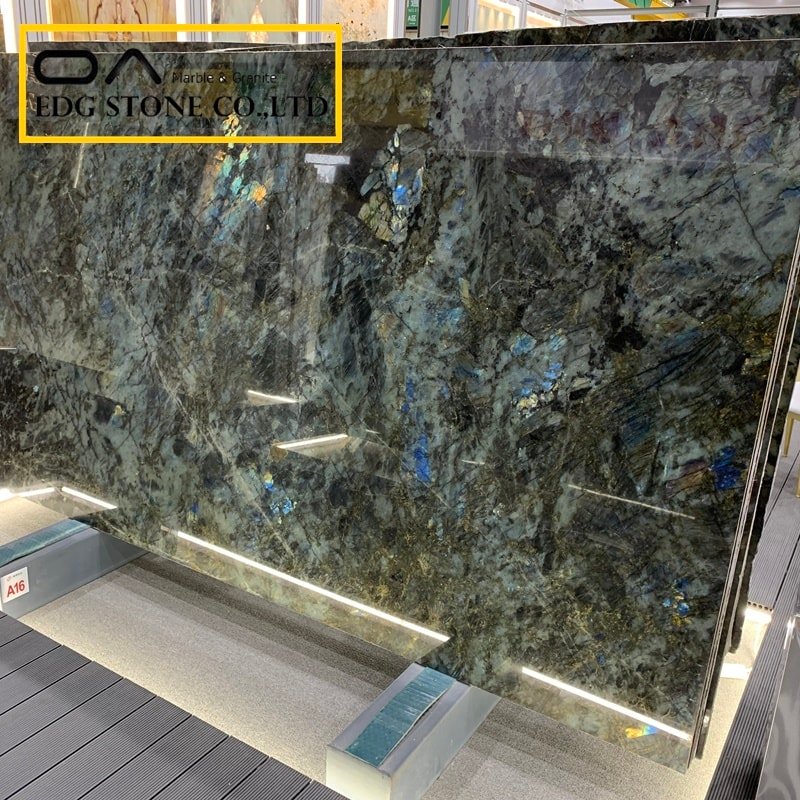
Labradorite vs. granite/quartz/onyx — cost and durability snapshot
Granite: broad price band; common granites can be $40–$100/sq ft (material), exotic granites up to $200+/sq ft. Labradorite often sits at the higher end of natural stone pricing due to rarity and decorative value.
Quartz (engineered): typically $60–$150/sq ft (material), non-porous and low maintenance; engineered quartz avoids some of the fabrication risks tied to labradorite but lacks unique labradorescence.
Onyx/Marble: can rival or exceed labradorite costs for rare onyx; these stones are more fragile and often used as accents.
Durability: Labradorite is a feldspathic stone and is reasonably hard, but can be more brittle in thin, translucent sections. Expect to seal and care for the stone as you would with other natural stones; avoid extreme thermal shocks on thin areas.
Where to buy Labradorite slabs — tips and sources
Direct wholesalers/quarries: If you are sourcing large projects or are a B2B buyer, contact exporters listed on global stone portals and verified suppliers—these often list FOB or ex-factory slab prices. (examples: stone wholesale listings and supplier catalogs).
Specialty natural stone dealers / showrooms: local stone yards and premium suppliers often carry selected labradorite slabs or can order special slabs; good for hands-on inspection.
Online marketplaces: platforms for unique slabs (marketplaces listing individual slabs with per-sq-ft pricing) are useful to find rare slabs and reference real listings and price points.
Fabricator stocking: Many fabricators keep a rotating inventory—ask for slab photos and digital measurements before buying. Always request full slab photos (not stock images) to assess flash and figure.
Buying checklist: verify slab thickness, origin, photos of the actual slab, shipping/duty terms, return/exchange policy, and whether the supplier provides installation referrals or in-house fabrication.
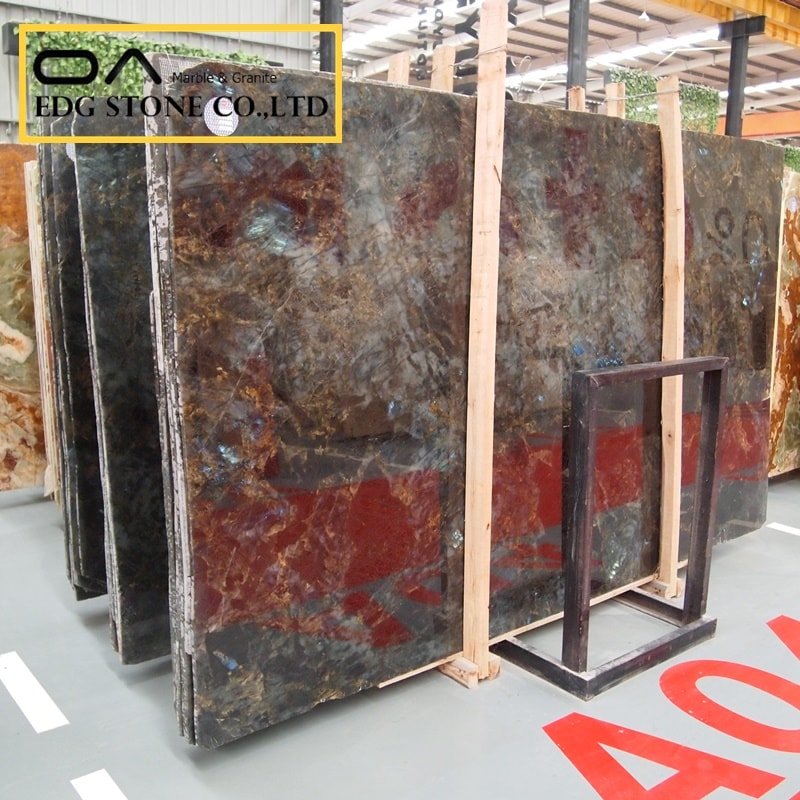
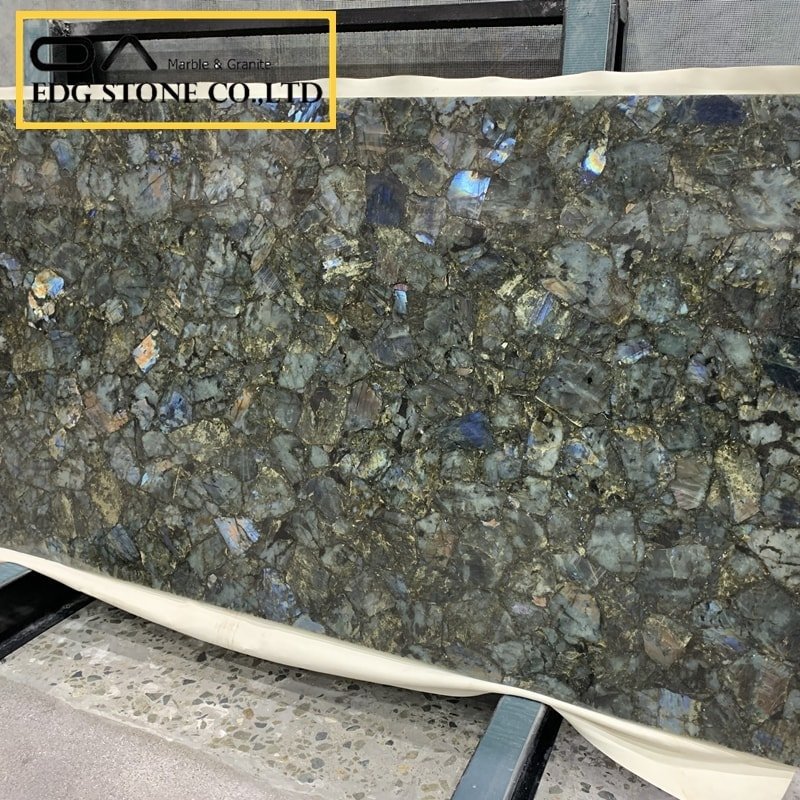
Durability, maintenance, and recommended finishes
Sealing: Like other natural stones, labradorite should be sealed (especially honed or porous specimens). Sealer frequency depends on finish and use; high-use kitchen areas typically need re-sealing every 1–2 years.
Stain & scratch resistance: generally good but not invulnerable — avoid cutting on the surface and use trivets for hot cookware.
Chips & repairs: high-figure slabs with translucent features may require resin fills or expert repair if chipped — factor that into long-term maintenance cost.
Finish selection: polished finish maximizes flash; leathered or honed finishes mute reflection but can hide wear better.
Regulatory & industry trends affecting cost and supply (important to pricing)
Regulation and workplace safety in the stone industry have tightened globally over the last decade:
OSHA & respirable crystalline silica: In the U.S., OSHA maintains silica exposure standards and targeted enforcement in engineered stone fabrication and installation. Fabricators must adopt wet cutting, local exhaust ventilation, monitoring, and training — these compliance costs increase shop overhead and final unit prices. 职业安全与健康管理局+1
Australia & engineered stone restrictions: Several jurisdictions have moved aggressively on engineered stone (high-silica products); Australia introduced strong controls and bans around engineered stone, influencing global supply chains and increasing scrutiny on all stone fabrication (fabricators investing to control silica see higher operating costs).
Global trend: regulators and industry bodies are pushing for better dust controls, worker medical surveillance, and, in some places, limits or bans on high-silica engineered materials. This trend increases costs for manufacturers, drives demand for lower-silica or safer processing methods, and could push more buyers toward natural, low-silica decorative slabs (or toward sintered/synthetic alternatives).
Bottom line: compliance and worker-safety investments are a non-trivial part of modern fabrication costs and will factor into quotes you receive from reputable fabricators.
Pricing example — how to estimate your job
Assume a 30 sq ft island countertop + 20 sq ft perimeter (total 50 sq ft install). Use three example tiers:
Budget / more common slab (material $60/sq ft, install $40/sq ft):
Material: 50 × $60 = $3,000
Fabrication & install: 50 × $40 = $2,000
Estimated total: $5,000Mid-range / attractive figured slab (material $140/sq ft, install $60/sq ft):
Material: 50 × $140 = $7,000
Fabrication & install: 50 × $60 = $3,000
Estimated total: $10,000Premium rare slab + complex work (material $220/sq ft, install $90/sq ft + bookmatching):
Material: 50 × $220 = $11,000
Fabrication & install: 50 × $90 = $4,500
Bookmatching / special edging & shipping premium: $2,500
Estimated total: $18,000
These illustrative examples reflect the broad market variance and real vendor listings where labradorite slabs are priced across those tiers.
Negotiation & procurement tips (for buyers or resellers)
Ask for full slab photos & dimensions (not stock photos).
Request yield calculations — how many linear feet / usable sq ft per slab.
Compare 2cm vs 3cm pricing and consider undermount sink options (3cm gives cleaner edges but costs more).
Get multiple fabricator quotes, including site measure, cutouts, edge profile, travel, disposal of old counters, and protective transport.
Confirm fabrication shop silica-safety practices — shops that comply will cost more but reduce long-term risk.
FAQ — Google hot questions (5 answers)
How much does a labradorite countertop cost per square foot?
Answer: Labradorite slab prices vary widely. Supplier and marketplace listings typically range from about USD $40 up to $300+ per square foot, depending on slab rarity, thickness, finish, and shipping; installed totals are higher once fabrication and labor are included.Is Labradorite more expensive than granite?
Answer: Often yes for rare labradorite with vivid flash — while common granite can be significantly cheaper, exotic granite varieties can approach similar price points. Compare actual slab photos and installed quotes for a fair comparison.Where can I buy Labradorite countertops or slabs?
Answer: You can buy from stone wholesalers/quarry exporters, specialty stone showrooms, or online slab marketplaces that list individual slabs. For projects, most buyers work with a fabricator who can source slabs and handle shipping/fabrication.How durable are labradorite countertops, and how should I maintain them?
Answer: Labradorite is fairly durable but can have thinner translucent areas; sealing, avoiding direct cutting, and using trivets protect the stone. Routine sealing (1–2 years) and gentle cleaners are recommended.Do safety regulations affect the price of Labradorite countertops?
Answer: Yes. Modern silica exposure standards and enforcement (OSHA and other national regulators) require wet cutting, HEPA and extraction systems, and monitoring — these increase fabrication overhead and prices. Some jurisdictions have tightened rules or restricted engineered stone, affecting global supply and shop operating costs. 职业安全与健康管理局+1
Semantic closing block — How / Why / What / Options / Considerations
Why: Why pay a premium — labradorite’s unique labradorescence and decorative impact make it a “feature stone”; rarity and slab continuity create scarcity-driven pricing.
What: What to expect — expect a wide price band ($40–$300+/sq ft material; installed totals significantly higher), and higher overhead for compliant fabricators due to silica control.
Options: Consider sourcing a remnant for a vanity (lower cost), use labradorite as an accent (bar top, island face) rather than full perimeter, or evaluate sintered or engineered alternatives if budget or durability is primary.
Consideration: Factor regulatory compliance (shop safety), shipping/duties, and post-install maintenance into your ROI calculation. If you’re a fabricator, disclosing compliance measures can justify premium pricing to risk-averse customers.
50 SEO tags (mix of buyer intent, product, and long-tail):
Labradorite countertop price, labradorite price per square foot, labradorite slab for countertops, lemurian blue labradorite price, spectrolite countertop cost, where to buy labradorite slab, labradorite countertops near me, labradorite granite countertop, labradorite slab wholesale, labradorite manufacturer, labradorite factory price, labradorite supply chain, labradorite cost per sq ft, moonstone countertop price, labradorite installation cost, labradorite durability, labradorite maintenance, buy labradorite slab, labradorite remnant for vanity, labradorite vs granite price, rare labradorite slabs, labradorite edge profiles, labradorite bookmatch, blue labradorite slab, lemurian blue granite slab price, labradorite wholesale supplier, labradorite export price, labradorite shipping cost, labradorite sealed vs unsealed, labradorite countertop quotes, labradorite fabricator tips, labradorite kitchen island cost, labradorite supplier China, labradorite supplier Brazil, labradorite slab suppliers near me, labradorite countertops installation, labradorite slab dimensions, labradorite thickness pricing, labradorite polished finish, labradorite honed finish, labradorite leathered finish, labradorite slab marketplace, labradorite vs quartz price, labradorite cost calculator, labradorite best uses, labradorite feature wall cost, labradorite vanity countertop price, labradorite slab photos, labradorite ROI.
